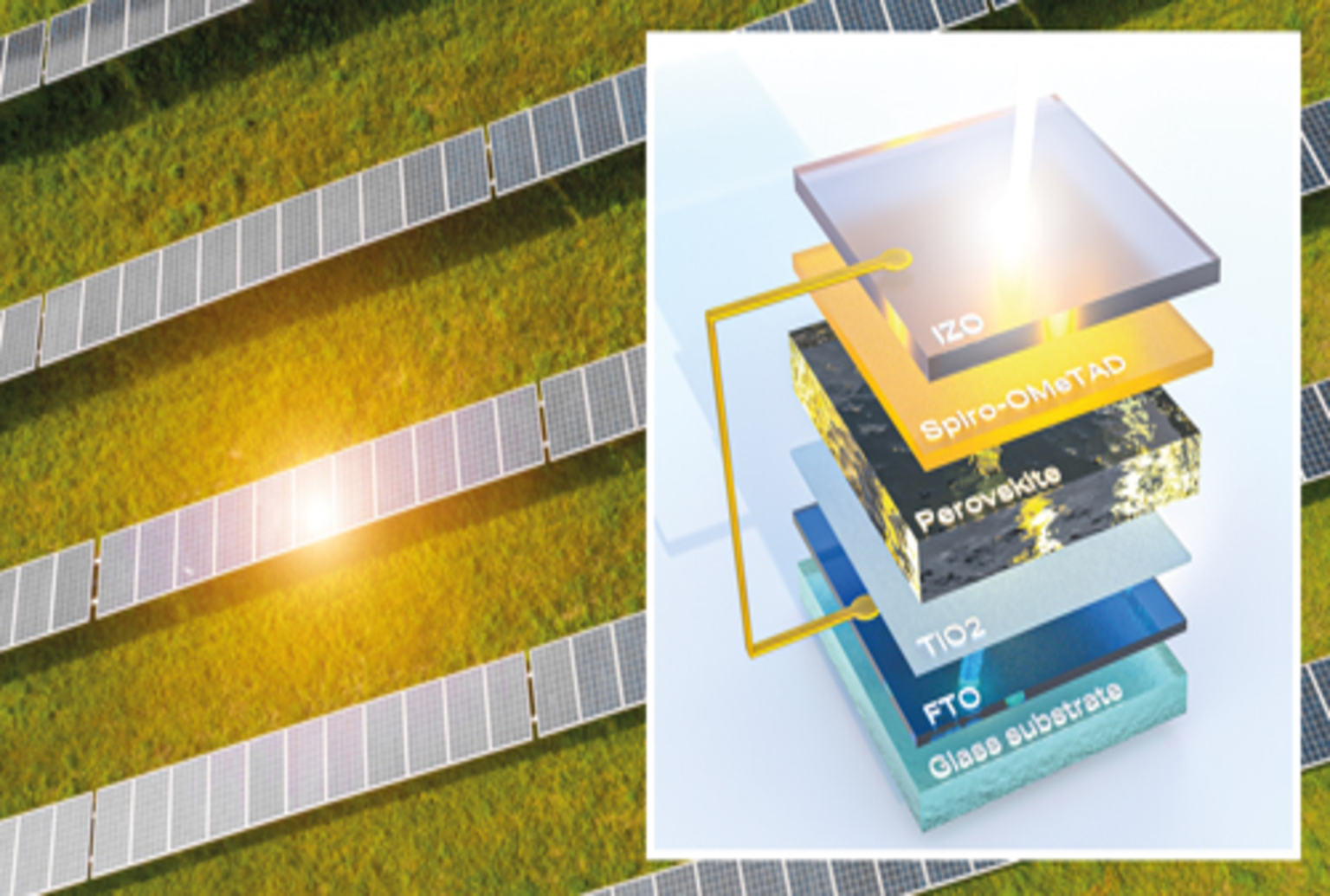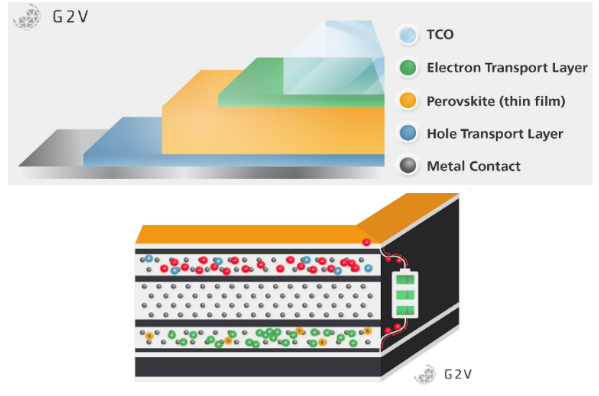Richard Corfield looks at the current efficiency of solar cell technologies and explores some of the contenders, such as perovskite solar cells, showing promise for improvement.
To date, the principal material from which solar cells have been constructed is mono-crystalline silicon – these have 97% of the market. Christophe Balliff, from Ecole Polytechnique Fédérale de Lausanne, thinks solar-cell efficiency based on crystalline silicon will rise to 24.5-26% in production, leading to 23-24% efficient modules on average by the end of the decade. However, other materials are now being looked at, principally in an effort to increase energy output and save costs.
The most important group of materials are perovskites. Perovskites are minerals composed of calcium titanium oxide (CaTiO2), discovered by the Russian scientist Gustav Rose in 1839. Russian mineralogist Lev Perovski conducted further research on the mineral, hence the name Perovskite.
The term perovskite refers to a whole family of compounds.1 The original mineral, calcium titanium oxide (CaTiO3), has a distinctive crystal configuration. It has a three-part structure, whose components have come to be labelled A, B and X, in which lattices of the different components are interlaced. The family of perovskites consists of many possible combinations of elements or molecules that can occupy each of the three components and form a crystal structure similar to that of the original perovskite itself.
Mix and match
Tonio Buonassisi, Professor of Mechanical Engineering at MIT and Director of the Photovoltaics Research Laboratory says: “Perovskites are highly tunable – you can mix and match atoms and molecules into the structure, with some limits. If you [try] to add a molecule that is too big, you’ll distort it [and destroy its structure and functionality].” 2
Perovskites, when layered, can increase the efficiency of solar cells from 25% to more than 40% over standard silicon cells. Perovskite offers highly efficient conversion of ultraviolet and visible light and excellent transparency to near-infrared light (the latter makes them useful in tandem solar cells, where silicon and perovskite are layered). Thus the thrust of worldwide research is into increasing the efficiency of perovskites to combine with – or replace – silicon-based technology.
The Dutch Organisation for Applied Scientific Research (TNO), in conjunction with other European research partners, is developing a novel tandem solar module. The module consists of perovskite/silicon solar cells layered on top of each other. This type of solar cell is monolithic, which means that the perovskite cell and the silicon cell are electrically connected (in a series). Importantly, this dual silicon/perovskite arrangement can achieve higher efficiencies than those achieved by current silicon-based solar modules, which results in more power per square metre and a lower cost per kWh.
'Perovskites are highly tunable – you can mix and match atoms and molecules into the structure, with some limits'
TNO notes that, on average, conventional silicon-based photovoltaic (PV) modules are increasing their average conversion efficiency by 0.5% per year. Hence PV energy production is becoming cheaper. However, there is an upper limit to the power conversion efficiency of conventional silicon-based PV modules that is set to be reached within three to five years: “It will become increasingly costly to maintain this positive trend, which is bound to slow down,” says TNO3. “As a matter of fact, any single material (or single junction) PV module is similarly affected by this limit, which has to do with thermalisation losses.
“The efficiency is a fundamental factor in lowering the cost of kWh by photovoltaic generation where the cost of the PV module itself is only a lowering fraction of the total cost – indeed material, installation and area (e.g. land) costs, but also operation and maintenance and capital costs, reduces with higher efficiency as more kWh per area is produced.”

Illustration of a modern perovskite high-performance solar cell module
Working in tandem
Maarten Ribbens, head of TNO Benelux, says: “TNO has been developing its tandem technology since 2016 and a handful of industrial partners eventually hope to deploy this technology in mass production. However, tandem PV module technology requires further development at relevant scale before it is industry-ready for introduction into the market.”4
Although valuable working in tandem with silicon, perovskites may one day replace silicon altogether. Professor Chunlei Guo, of the University of Rochester, is clear about their potential. “Perovskites are a new type of materials to possibly displace silicon,” he says. “For solar cell materials, the most promising alternative is perovskites. They have a comparable efficiency [to silicon] but are far cheaper to make.” 5
Guo’s group is focused on developing perovskite solar cells using a physics-based approach to synthesising perovskites.6,7 Its approach is to use a substrate layer of metal, or alternating layers of metal and dielectric material instead of glass. This is different from the way that traditional perovskite solar cells are constructed, where the perovskite is deposited as a film from solution onto a glass surface. By using an alternating substrate rather than glass, Guo and his co-authors found they could increase the perovskite’s light conversion efficiency.
“No one else has come to this observation in perovskites,” says Guo. “All of a sudden, we can put a metal platform under a perovskite, utterly changing the interaction of the electrons within the perovskite. Thus, we use a physical method to engineer that interaction.”
Another way of thinking about this is that it is like adding a mirror to the perovskite photon absorbing layer. The way that perovskites and silicons generate electricity is when electrons in the materials are excited by incoming photons. This causes them to escape from the atoms they orbit. These freed electrons can then be used to generate electrical current. However, the freed electrons leave holes behind them. Sometimes, these electrons are recaptured by the ‘holes’, which decreases the overall current and thus the overall efficiency of the material.
'As new perovskites emerge, we can then use our physics-based method to further enhance their performance'
When electron holes recapture electrons, it is known as electron recombination. The research team at the University of Rochester found it could reduce electron recombination in perovskite by placing it on a substrate made up of either silver or alternating layers of silver and aluminium oxide.
Surprising physics
Guo’s lab demonstrated that such recombination could be prevented by combining a perovskite material with either a layer of metal or a metamaterial substrate consisting of alternating layers of silver, a noble metal and aluminium oxide, which is a dielectric.
The result was a significant reduction of electron recombination through “a lot of surprising physics,” Guo says.7 “In effect, the metal layer serves as a mirror that creates reversed images of electron-hole pairs, weakening the ability of the electrons to recombine with the holes.”
Perovskites are not yet ready for practical large-scale applications. In particular, their tendency to degrade relatively quickly limits their usefulness.
Currently, researchers are racing to find new, more stable perovskite materials. One approach is the incorporation of silver iodide or polyethylene oxide in certain perovskites, improving crystallisation and nucleation and therefore extending the life of the perovskite.8
Another concern with perovskites is that they commonly use lead, which puts warning signals in front of many prospective users. However, tin-based perovskites have recently been suggested as a replacement for lead perovskites.9 Gallium arsenide is another potential candidate for solar cells, but remains expensive to exploit.10
The future of solar power therefore looks set to be with perovskites and physics-based solutions to their exploitation for the time being. “As new perovskites emerge, we can then use our physics-based method to further enhance their performance,” concludes Guo.
References
1. Explained: Why perovskites could take solar cells to new heights | MIT News | Massachusetts Institute of Technology
2. Explained: Why perovskites could take solar cells to new heights | MIT News | Massachusetts Institute of Technology
3. Dutch-German consortium developing simplified tandem solar modules | Optics.org
4. Dutch-German consortium developing simplified tandem solar modules | Optics.org
5. Gigantic suppression of recombination rate in 3D lead-halide perovskites for enhanced photodetector performance | Nature Photonics
6. Gigantic suppression of recombination rate in 3D lead-halide perovskites for enhanced photodetector performance | Nature Photonics
7. Perovskites, a ‘dirt cheap’ alternative to silicon, just got a lot more efficient | ScienceDaily
8. Perovskite photovoltaics: stability and scalability | Scientific Reports (Nature.com)
9. Stable Tin-Based Perovskite Solar Cells | ACS Publications
10. Gallium arsenide solar cells | Appropedia
Acknowledgements
We thank Gianluca Coletti (TNO), Chunlei Guo (University of Rochester) and Christophe Ballif (Ecole Polytechnique Fédérale de Lausanne) for their contribution to this article.
Sponsored: Let there be light
Every life process on Earth is powered by the sun. It provides the energy required to cultivate most of our food, decomposing its remains and converting it into the fuel we burn today to continue harvesting energy 1.
While this may appear to be a ‘renewable’ life cycle, nothing could be further from the truth. Fossil fuels are a finite source of energy, and our over-reliance and increased consumption has led to well-documented environmental concerns that necessitate immediate action2.
The urgency to investigate reliable and renewable energy sources has accelerated over the years, with an unsurprisingly large focus on solar energy. Did you know that ~739kWm-2 is incident on the Earth’s surface from the sun2? This is precisely why harnessing the sun’s energy and light to invent, test and apply technology in an eco-friendly manner is crucial for humanity’s advancement1 – and solar simulation can help achieve just that.
What is solar simulation?
Solar Simulation technology aims to imitate the sun for use in controlled environments. Its main purpose is to provide a means for manageable indoor testing facilities under strict laboratory environments by producing illumination that mimics natural sunlight 1. The scientific instrument used to simulate sunlight is called a solar simulator. These are specifically designed to deliver intensity and spectral composition as close as possible to natural light.
Sunlight is composed of multiple wavelengths, some of which coincide with the colours we see, and others that are invisible to the naked eye: radio waves, microwaves, infrared (IR) and ultraviolet (UV) radiation1. The amount of sunlight striking the Earth’s surface can vary due to: variations in earth/sun distance, scattering and absorption by the atmosphere, and different incidence angles at different locations. It is, therefore, very important to account for all these factors and implement them in design considerations to produce more efficient and reliable solar devices.

Figure 1: (a) layer order in a perovskite solar cell, (b) photovoltaic effect
Perovskite solar cell technology
To harness as much of the sun’s energy as possible, the materials used to fabricate solar devices must be highly transparent to visible light to maximise conversion efficiency.
The one thing that sets perovskites apart from other candidates such as silicon or cadmium telluride, is the incredible level of flexibility in their structure. Owing to how atoms are shared between unit cells of material, it is possible to synthesise hundreds of perovskite crystals via different component combinations. This makes it possible to stress perovskite crystals into several other configurations – which can greatly modify their physical and electronic properties.
Increasing internal stress within the crystal can prevent the formation of crystal defects which has proven to be extremely useful in combating reduced Power Conversion Efficiency (PCE) and increasing the lifetime of solar cells3. This flexibility in the chemical structure of perovskite cells makes them a highly desirable platform for producing tuneable solar cells for various applications. However, it is our understanding of their chemical construction, and mature fabrication processes that enable the production of high-quality solar cells.
One of the most sought-after properties of a solar cell is its PCE. At higher PCEs, solar panels can generate more power via the photovoltaic effect while simultaneously producing less heat. This makes improving the efficiency of solar cell technology a very hot topic in research3. To achieve maximum PCE, a perovskite layer needs to be accompanied by other material layers called charge transport layers (CTLs) which act as neutral semiconductive materials where charge separation can be induced. Due to the high carrier mobility in perovskite layers, the application of CTLs is sufficient to produce an E-field throughout the layer after electron-hole pair creation.
Before deploying solar cells into the world, they must be thoroughly tested. It is important to validate whether they are acceptable by investigating the cell’s electronic properties and crystallinity. The most common testing method is based on a flashing technique: a solar simulator light source is pulsed between 1 and 30 ms and responsivity data of the solar cell (I-V characteristics) is collected and compared against well-established NREL data3.
Ajan Ramachandran PhD, an Optics Research Scientist at Rayleigh Solar Tech says, “In our perovskite testing the ability to customise the intensity and wavelength profiles, all while maintaining excellent uniformity and stability has been key in our perovskite manufacturing processes”4. Rayleigh Solar Tech’s mission is “to find ways to harness solar energy and make it useful unlike anything ever seen before” because they believe solar energy is the key to a more sustainable future4. They see a “brighter future with perovskite” and so do we – G2V Optics LED solar simulators are here to help you see the light.
References
1 Solar Simulation Technology G2V Optics
2 Turner, Daniel, et al. Recent enterprises in high-rate monolithic photo-electrochemical energy harvest and storage devices."Current Opinion in Electrochemistry (2023): 101243.
3 Perovskite Solar Cell Technology G2V Optics
4 https://rayleighsolartech.com/
Further information
For more information on G2V optics products, please email Photonic Solutions on: sales@photonicsolutions.co.uk


